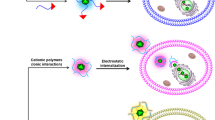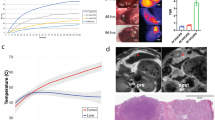Abstract
Selective gene transfer to tumor is critical in cancer gene therapy. We previously used ionizing radiation to improve adenovirus uptake in intrahepatic tumors but liver cytotoxicity associated with the viral administration still occurred. Here, we explore the potential of radiation for improving gene delivery by a virus-mimicking nanoparticle, transferrin (Tf)-cationic liposome-DNA complex (Tf-lipoplex). Transduction by Tf-lipoplex was highly efficient in various cell lines and further increased by radiation in a dose- and time-dependent manner. This radiation induction, which was associated with an increase in Tf-lipoplex uptake (3- to 4-folds in hepatocytes WB and lung cancer cells, LLC1), was absent when a Tf-deficient complex was used or abolished by the presence of free Tf, suggesting that Tf receptor (TfR) interaction is required for radiation induction. Radiation (10–20 Gy) markedly induced transgene (LacZ) expression in LLC1 xenografts (3.5- to 7.4-folds), correlating with increased plasmid content and TfR expression in irradiated tumors. Moreover, Tf-lipoplex-mediated gene expression was not observed in the liver or other normal tissues regardless of radiation treatment. We conclude that radiation improves Tf-lipoplex gene delivery selectively to tumor cells both in vitro and in vivo. Our findings may provide insight in developing ligand-specific lipoplex for molecularly targeted cancer gene therapy.
This is a preview of subscription content, access via your institution
Access options
Subscribe to this journal
Receive 12 print issues and online access
$259.00 per year
only $21.58 per issue
Buy this article
- Purchase on Springer Link
- Instant access to full article PDF
Prices may be subject to local taxes which are calculated during checkout








Similar content being viewed by others
References
Muruve DA . The innate immune response to adenovirus vectors. Hum Gene Ther 2004; 15: 1157–1166.
NIH Report: Assessment of adenoviral vector safety and toxicity: report of the National Institutes of Health Recombinant DNA Advisory Committee. Hum Gene Ther 2002; 13: 3–13.
Zhang M, Li SP, Nyati MK, DeRemer S, Parsels J, Rehemtulla A et al. Regional delivery and selective expression of a high-activity yeast cytosine deaminase in an intrahepatic colon cancer model. Cancer Res 2003; 63: 658–363.
Pirollo KF, Xu L, Chang EH . Non-viral gene delivery for p53. Curr Opin Mol Ther 2000; 2: 168–175.
Joshee N, Bastola DR, Cheng PW . Transferrin-facilitated lipofection gene delivery strategy: characterization of the transfection complexes and intracellular trafficking. Hum Gene Ther 2002; 13: 1991–2004.
Keer HN, Kozlowski JM, Tsai YC, Lee C, McEwan RN, Grayhack JT . Elevated transferrin receptor content in human prostate cancer cell lines assessed in vitro and in vivo. J Urol 1990; 143: 381–385.
Inoue T, Cavanaugh PG, Steck PA, Brunner N, Nicolson GL . Differences in transferrin response and numbers of transferrin receptors in rat and human mammary carcinoma lines of different metastatic potentials. J Cell Physiol 1993; 156: 212–217.
Elliott RL, Elliott MC, Wang F, Head JF . Breast carcinoma and the role of iron metabolism. A cytochemical, tissue culture, and ultrastructural study. Ann N Y Acad Sci 1993; 698: 159–166.
Ishida O, Maruyama K, Tanahashi H, Iwatsuru M, Sasaki K, Eriguchi M et al. Liposomes bearing polyethyleneglycol-coupled transferrin with intracellular targeting property to the solid tumors in vivo. Pharm Res 2001; 18: 1042–1048.
Yanagihara K, Cheng H, Cheng PW . Effects of epidermal growth factor, transferrin, and insulin on lipofection efficiency in human lung carcinoma cells. Cancer Gene Ther 2000; 7: 59–65.
Xu L, Pirollo KF, Tang WH, Rait A, Chang EH . Transferrin-liposome-mediated systemic p53 gene therapy in combination with radiation results in regression of human head and neck cancer xenografts. Hum Gene Ther 1999; 10: 2941–2952.
Xu L, Pirollo KF, Chang EH . Tumor-targeted p53-gene therapy enhances the efficacy of conventional chemo/radiotherapy. J Control Release 2001; 74: 115–128.
Xu L, Pirollo KF, Chang EH . Transferrin-liposome-mediated p53 sensitization of squamous cell carcinoma of the head and neck to radiation in vitro. Hum Gene Ther 1997; 8: 467–475.
Rasmussen H, Rasmussen C, Lempicki M, Durham R, Brough D, King CR et al. TNFerade biologic: preclinical toxicology of a novel adenovector with a radiation-inducible promoter, carrying the human tumor necrosis factor alpha gene. Cancer Gene Ther 2002; 9: 951–957.
Senzer N, Mani S, Rosemurgy A, Nemunaitis J, Cunningham C, Guha C et al. TNFerade biologic, an adenovector with a radiation-inducible promoter, carrying the human tumor necrosis factor alpha gene: a phase I study in patients with solid tumors. J Clin Oncol 2004; 22: 592–601.
Zhang M, Li SP, Li J, Ensminger WD, Lawrence TS . Ionizing radiation increases adenovirus uptake and improves transgene expression in intrahepatic colon cancer xenografts. Mol Ther 2003; 8: 21–28.
Qian J, Yang J, Dragovic AF, Abu-Isa E, Lawrence TS, Zhang M . Ionizing radiation-induced adenovirus infection is mediated by dynamin 2. Cancer Res 2005; 65: 5493–5497.
Geng L, Osusky K, Konjeti S, Fu A, Hallahan D . Radiation-guided drug delivery to tumor blood vessels results in improved tumor growth delay. J Control Release 2004; 99: 369–381.
Jain PT, Gewirtz DA . Sustained enhancement of liposome-mediated gene delivery and gene expression in human breast tumour cells by ionizing radiation. Int J Radiat Biol 1999; 75: 217–223.
Li S, Yu B, An P, Chen G, Lu W, Cai H et al. Combined liposome-mediated cytosine deaminase gene therapy with radiation in killing rectal cancer cells and xenografts in athymic mice. Clin Cancer Res 2005; 11: 3574–3578.
Xu L, Frederik P, Pirollo KF, Tang WH, Rait A, Xiang LM et al. Self-assembly of a virus-mimicking nanostructure system for efficient tumor-targeted gene delivery. Hum Gene Ther 2002; 13: 469–481.
Lakkaraju A, Rahman YE, Dubinsky JM . Low-density lipoprotein receptor-related protein mediates the endocytosis of anionic liposomes in neurons. J Biol Chem 2002; 277: 15085–15092.
Ran S, Thorpe PE . Phosphatidylserine is a murder of tumor vasculature and a potential target for cancer imaging and therapy. Int J Radiat Oncol Biol Phys 2002; 54: 1479–1484.
Lahorte M, Vanderheyden JL, Steinmetz N, Van de Wiele C, Dierckx RA, Slegers G . Apoptosis-detecting radioligands: current state of the art and future perspectives. Eur J Nucl Med Mol Imaging 2004; 31: 887–919.
Ran S, He J, Huang X, Soares M, Scothorn D, Thorpe PE . Antitumor effects of a monoclonal antibody that binds anionic phospholipids on the surface of tumor blood vessels in mice. Clin Cancer Res 2005; 11: 1551–1562.
Timmerman RD, Kavanahg BD, Chinsoo Cho L, Papiez L, Xing L . Stereotactic body radiation therapy in multiple organ sites. J Clin Oncol 2007; 8: 947–952.
Acknowledgements
We thank Mary Davis (Radiation Oncology, University of Michigan) for her review of the paper. This work was supported partly by NIH grants CA80145, CA121830, CA128220, and CA84117, and the Cancer Center Core Grant CA46592 from the University of Michigan.
Author information
Authors and Affiliations
Corresponding author
Rights and permissions
About this article
Cite this article
Abela, R., Qian, J., Xu, L. et al. Radiation improves gene delivery by a novel transferrin-lipoplex nanoparticle selectively in cancer cells. Cancer Gene Ther 15, 496–507 (2008). https://doi.org/10.1038/cgt.2008.26
Received:
Revised:
Accepted:
Published:
Issue Date:
DOI: https://doi.org/10.1038/cgt.2008.26



